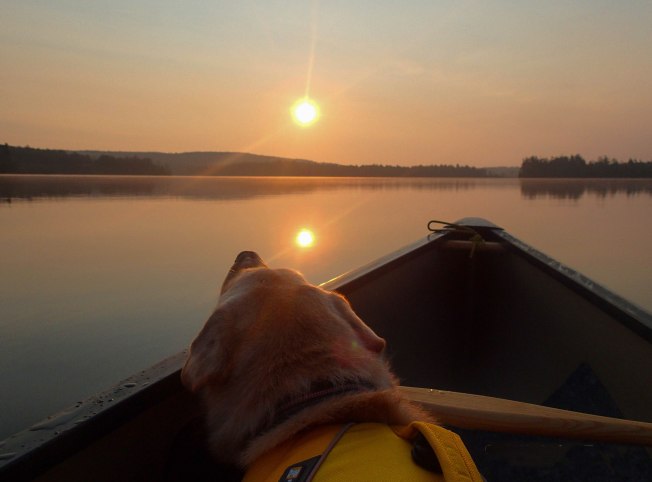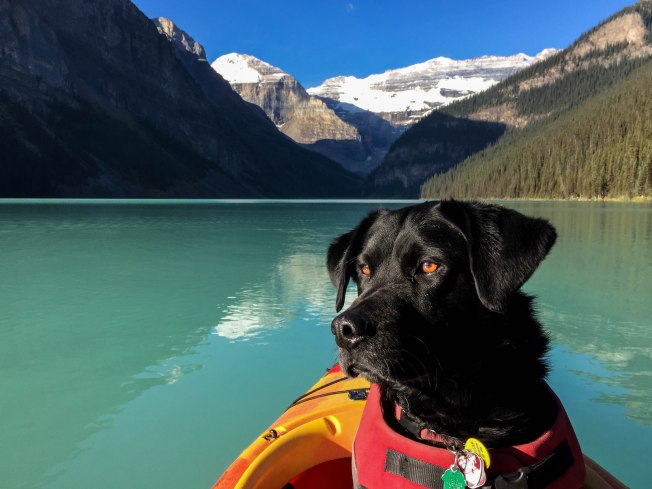
This article offers some tips and hints that we have found helpful in the development of our Paddle Pups. It is designed merely as a guide, since every dog, paddler, and individual’s expectation is different. It was first published a few years ago, on the backcountryk9.com blog….I have updated it just a smidgen, since we actually use solo boats now more than the tandem canoe. However, the information in it has consistently proven helpful, so we once again offer it to those of you curious about turning your dog into the perfect paddling partner.
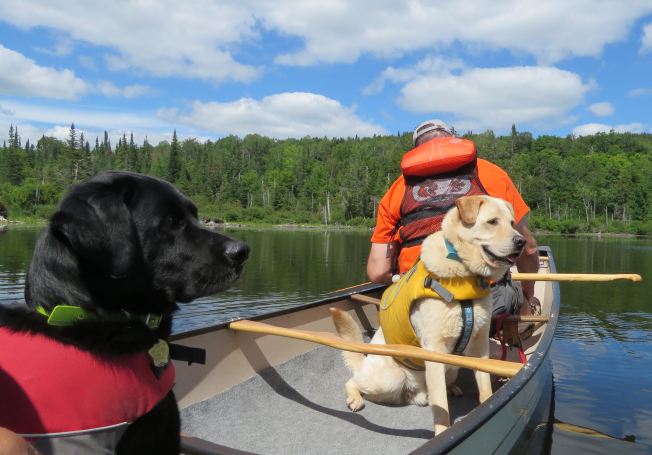
“There is one thing I should warn you about before you decide to get serious about canoeing [with dogs] . You must consider the possibility of becoming totally and incurably hooked on it”. Bill Mason, Path of the Paddle
I made the “with dogs” addition to the Mason quote, because we have admittedly become incurably addicted to paddling with our dogs . We are avid canoeists, and advocates for safe and fun outdoor adventures with dogs. We share with you a few pointers, to help you and your dogs have a great paddling experience, one you will want to continue for many years!
No way…you put TWO dogs in your canoe with you? Oh, we’ve heard that one before. We started out with one dog, who took to canoeing like a pro. He paddled with us for a few summers as a “solo dog”. Then when we adopted a second dog, we faced new challenges. Well, yes, we were able to put 2 large lab mutts in our 16’6” canoe, and off we would go, paddling a few days every week, from early-May to end of October, having great fun on multi-day canoe camping trips, day trips, and picnic paddles. We love exploring new waterways, and to date have explored over 100 different lakes, and have paddled and camped in 7 states and 5 provinces. I now get out as many as 180 days per year ( a dry suit from Mythic Gear permits safe early and late season paddling).

We enjoy canoeing as a relaxing activity, which gets us out on the beautiful lakes of northern New England. We use the tandem canoe for some trips, but most of our outings now involve the use of a 13 foot solo canoe and a 12 foot kayak. One dog prefers the canoe, and the other likes his kayak, so both dogs and paddlers are happy! The tips here were also used to acclimate Edgar to his kayak, and he successfully transitioned into being a pup who loves the tandem canoe, the solo canoe, and his kayak.
If your dog can happily ride in a car, he can be a good candidate for canoeing or kayaking. Canoeing does not provide the exercise that hiking, skijoring, or running may, but we have found our dogs love the peaceful movement of the canoe. They get to see wildlife, explore islands and beaches, camp out with us, and swim to cool off.
If you are deciding which canoe to use, we suggest you start with a stable, family-suitable canoe. Aluminum canoes can get very hot and noisy, both unpleasant conditions for a dog… so we suggest avoiding them. If you are going to check out canoes prior to purchasing, we suggest you bring along your dog. It is helpful to have the pup try out the canoe for size, too…some configurations are more suitable for dogs than others. Even better, if you go for a test paddle, bring your dog along, too, wearing a life jacket, of course.
Be sure to have a covering on the floor of the boat. Your dog will need to adjust to the movement of the canoe, and if he slips or slides, he will be uncomfortable, insecure, and will not be able to settle down. We have used yoga mats, backpacking pads, foam mats…all with varied success. We found that on many of these mats, once water gets under them, they will slide. Our preferred solution is a section of good quality indoor-outdoor carpeting. This material can be cut to fit nearly the length of our canoe, protects the interior from the dogs’ claws, and also is easy to clean, dry, and roll up for storage. Note: For the kayak, we have installed an adhesive Punt Surf traction mat, designed for SUPs. That has worked very well in the kayak interior.
Be sure that you are confident paddlers before you take your dog out in the canoe or kayak. You do not have to be expert paddlers, but even on quiet waters, you are going to have a miserable (and dangerous) time, if you and your dog are both uncertain and inexperienced. Select a quiet, calm body of water, with an easy access launch site, for your first excursions. Choose a time of day when there are fewer other boaters or dogs around; the smoother the water, and the fewer distractions, the more successful your initial trips will be.
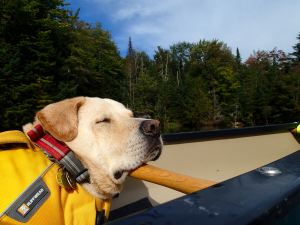
Your dog does not have to be a good swimmer to have a safe trip. In fact, for all dogs, we suggest the use of a dog life jacket. This jacket can provide thermal protection in cool water, provides a nice handle should you need to lift your dog out of the canoe or the water, and makes your dog visible to other boaters should he end up in the water. Neither of our dogs is a skilled swimmer; should we capsize, I would prefer to deal with a guided, floating dog, than one who is struggling. We periodically have our dogs practice swimming while wearing their life jackets, so they gain confidence in the water.
Do not forget to wear your PFD! No matter how strong a swimmer you may be, should you need to assist your dog in the water, lack of a PFD could be detrimental to your health. According to the American Canoeing Association, 85% of canoeist who drown were not wearing PFDs. Consider that, and the fact that there would be added exertion required in trying to help your dog!
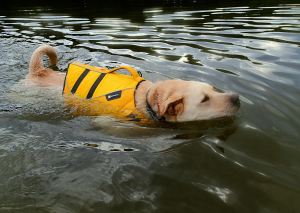
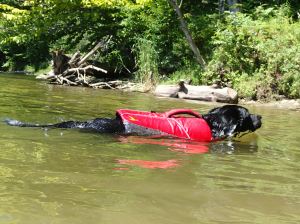
It is advisable to have your dog well versed in basic obedience commands, such as sit, stay, down, and “hup” ( or another command you may select for getting in and out of the boat ). We had each of our dogs work on these skills in the boat while on dry land before they ever went onto canoe on the water. This included having them sit, stand, and lie down while we rocked and wiggled the boat. This training has saved us from disaster more than once, as we have often encountered heavy waves. Each of our dogs began his canoeing career by sitting in the same canoe compartment with the stern paddler….the dog was secure, easy to hold, and there was less chance of unexpected motion from the dog. The dog then “graduated” into riding in his own section, once he had demonstrated reliable canoe behavior.
Be sure to practice good canoeing etiquette with your dog. We do not allow the dogs to bark while in the canoe. We paddle near some amazing wildlife, and would not want our dogs to harass the loons, beaver, eagles, herons, moose, or other animals ( or paddlers) we may see.
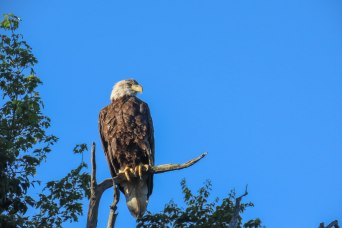
We do have a standard routine for getting in and out of the boat. Dogs go in first, one at a time, upon command…then we go in. The dogs are taught that we decide when they enter and exit the boat. Upon landing, we reverse the process. Most capsizings happen within 10 feet of shore, and keeping a strict routine can help prevent this. The dogs only get in and out of the boat when we decide it is safe for all of us.
Our dogs get very excited when they see that they are going in the canoe! If your dog has trouble settling down, you may want to take him for a run, or a short exercise session first. It is also a good idea to let him take care of any potty business before he gets into the boat!
On longer paddle trips, we try to stop periodically and let the dogs out to run around a bit, to stretch and complete any unfinished “business”. Be sure to clean up after your dogs, as we are responsible for them, and for keeping our waters clean.
We like to keep short leashes available for the dogs while we are canoeing, primarily for guiding them at the launching sites, where there may be broken glass or other hazards, or if we take out at locations where leashes are required. But, never have a leash on your dog while in the canoe or kayak. We have used regular leashes coiled up with gear-ties, secured to their life jackets, but that gets bulky, and they could come loose. It is crucial you do not have any hanging lines or leashes that could cause entanglement if the boat tips, and NEVER tie your dog to the boat. We have had great success using the Ruffwear Quick Draw Leash, since it serves wonderfully as a canoeing leash. It stays wrapped over the dog’s regular collar until needed, so it is both safe, and handy.
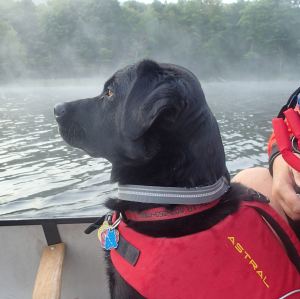
We always carry drinking water for our dogs in the boat, using the OllyDog Olly Bottle or the H2O4K9 bottle. It can get hot in a canoe in the summer, and it is important that we, and the dogs, keep hydrated. Yes, they can lean over the gunwales to access water…but we do not always want the dogs drinking from the water we may be paddling across. It also can become quite the “tippy-canoe or puppy, too” experience if your dog suddenly decides to drink the lake.
Our trips always have us carrying a canoe bag with essential safety gear which includes a dog first aid kit. Unfortunately, as we mentioned earlier, even in remote canoeing areas we have found bottle caps and broken glass on launching and landing sites. In this kit, we always have a few cordura musher’s booties; should we have to bandage a paw, the use of a bootie will help keep a bandage in place.
One of the most important elements to having a successful dog paddling expedition is your attitude! Have fun… remember that this activity may be a bit unsettling to your dog. Go slowly…start with short trips, so your dogs can earn your praise while he practices his canoeing skills. Take Photos! You will want to look back some day and realize how far you and your dog have come, and laugh at your adventures (and misadventures!). Canoeing is a “lifetime activity” for our dogs. Once their skijoring and kick-sledding days are over, we know that they will continue to enjoy canoeing with us, a shared activity we all love.
